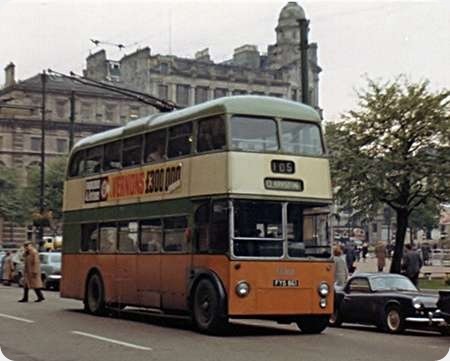
Newcastle Corporation
1948
BUT 9641T
Metro Cammell H40/30R
Another from the Job lot of photos I bought a while ago this time an atmospheric shot of Newcastle’s Byker Depot in 1948. An impressive line up of 20 new BUT 9641T’s with Metro Cammell H40/30R bodies, they were LTN 479 – LTN 498 fleet numbers 479/98.
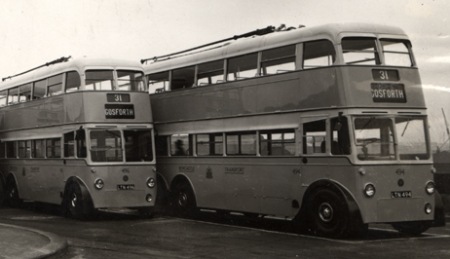
Newcastle ordered 70 of this type, and this first batch were identical to London’s Q’s where as the remaining 50 had the standard Newcastle destination indicator layout. I’ve heard it said ‘but not confirmed’ that these vehicles were built for LT but diverted to Newcastle. The first Newcastle trolley buses began to replace the trams in 1935, but because of the war it wasn’t until 1950 that the trams finally disappeared. I think I’m right in saying that Newcastle had the largest trolleybus system outside London, they had 28 routes and a fleet of 204 vehicles, but unlike the trams they never ran south of the Tyne into Gateshead, and as far as I’m aware it was only the routes into Wallsend that ventured beyond the City boundaries. The last one ran in 1966, and in resent years it’s often been said that they should never have got rid of them, but hindsight is an exact science
Photograph and Copy contributed by Ronnie Hoye
24/06/12 – 15:26
A couple of photographs of some very impressive vehicles. Thank you for posting them.
I knew Noel Hanson who co-authored with Tom Canneaux the book ‘The Trolleybuses of Newcastle upon Tyne’. Noel was a lovely man and he spent a great deal of time and effort in trying to get to the bottom of the events that led to Newcastle receiving LPTB style Q1s. In the Second Edition of the book, published in 1985 by Newcastle City Libraries, the authors added a chapter that covers this story in detail.
In November 1946 Newcastle Corporation placed orders for 50 3-axle trolleybuses with 20 chassis from BUT and 30 from Sunbeam. Metro-Cammell were to body the BUTs. In addition the Corporation had earlier ordered a number of 2-axle trolleybuses too, including 36 Karrier chassis to be bodied by Metro-Cammell. These were delivered after the Q1s as Sunbeam F4s.
Anyway, to cut a long story short in September 1947 Newcastle Corporation was pressing Metro-Cammell to confirm delivery dates of trolleybuses that were on order. Attention focused on expediting delivery of the 36 2-axle vehicles. Representatives of English Electric – who were supplying the electrical equipment and motors – and Metro-Cammell were summoned to Newcastle. English Electric offered to commence delivery of the electrical equipment in the November for the 20 3-axle BUTs. The representative from Metro-Cammell said that vehicle delivery dates were receding but offered delivery of the 20 3-axle BUTs in the early part of 1948 on the basis of the Corporation being prepared to accept the standard LPTB body design rather than the City’s own specified design. The offer was, of course, immediately accepted.
Ronnie is correct that the Wallsend (Park Road) route lay outside the City Boundary but the Gosforth Park, Polwarth Drive, Hollywood Avenue and Grange Estate routes were also beyond The City and County of Newcastle upon Tyne (to use the correct title).
Kevin Hey
24/06/12 – 15:26
These were quality trolleybuses and Newcastle were wise to copy the London Transport body specification. In order of delivery from Metro Cammell, these twenty came before the main London order and a further order after London then went to Glasgow. The Newcastle trolleybuses were the closest in appearance to the London class Q1 whereas Glasgow did insist on their own style indicators. Newcastle did make changes such as indicators and sliding windows with a later order of similar Metro Cammell BUTs which came in 1949/50.
Richard Fieldhouse
24/06/12 – 15:28
One of the reasons that many trolleybus systems were abandoned in the late 1950’s and early 1960’s was the massive amount of town centre re-development that was going on or was planned. The disruption to overhead installations and the level of investment that would have been required to keep pace with the changes to streets and roads would have been prohibitive. Coupled with the relatively cheap price of oil and a lack of environmental awareness (compared to today) led to many operators giving in and closing their systems.
In fairness many of the trolleybus fleets in the early 60’s were fairly elderly but there were exceptions and the Bournemouth dual entrance Sunbeams and Reading forward entrance Burlinghams were thrown away with many years of life left in them. It was a great shame.
Philip Halstead
25/06/12 – 07:52
Sorry about that, Kevin, I completely forgot that Gosforth was also a victim of the abortion that came about with the creation of Tyne and Wear. At the time I lived in the old County Borough of Tynemouth, and we had our own Ambulance service, Fire Brigade and Police Force, but that’s another story, back to Trolleybuses. I can understand that City Centre redevelopment was one of the major factors in the demise of Trolleybus networks, but that seems a bit ironic now when, in Newcastle anyway, many of the buildings that were thrown up ‘sorry’ erected in the 60’s, are now themselves being demolished. On the other hand, if Trolleybuses were still around now the biggest problem would probably be cable theft!
Ronnie Hoye
25/06/12 – 07:53
What a fantastic line up of Newcastle Trolleybuses. When you consider each one would have to be positioned by a towing vehicle I wonder how long it took to get these trolleys lined up for this photo.
Eric Bawden
25/06/12 – 07:54
Philip has indicated some reasons why trolleybus systems were abandoned after the war, but there were others, too. Post-war nationalisation of the power industry ended generation by municipal authorities, part of which went to their trams/trolleybus fleets and was subsidised. Full rates had to be paid thereafter, making trams/trolleybuses less competitive and attractive than hitherto! Then, the electrical infrastructure, usually installed for electric trams, around 1900, was worn out, as were the original trolleybuses built in the 1930’s, all patched up and inadequately maintained during the war.
There never was a surplus of London trolleybuses which were passed on to other operators. ‘The London Trolleybus’ by Ken Blacker states that operators were told by the M of WT that a limited number of trolleybuses were to be produced. LPTB, along with others were asked to put in their bids, but LPTB was told specifically that a maximum of 50 would be their allocation and who would be the chassis, body and electrical suppliers. LPTB quietly told the ministry that it needed 77 to replace the fast collapsing ‘Diddlers’ and war losses, leading to the increased allocation and delivery of the first Q1 in January 1948. There were also orders for the 34 for Glasgow and 20 for Newcastle, and LPTB (by then LTE) generously gave permission for their, primarily, body design, using the same patterns/jigs, to be used for these orders, too, to speed up deliveries. Glasgow did mange to get its own pattern of destination indicators, but internally, both were identical internally to the London ones, save for the Newcastle ones having Newcastle’s seat coverings and polished wood fittings. Newcastle’s were delivered between February and April 1948, with Glasgow’s at much the same time. Glasgow annoyed LTE by using the London ‘T’ logo front and back and had to take them off quickly! They were all about a year late in being delivered for a variety of reason, but gave stirling service over the years. One quirk was the lack of nearside opening cab windows, compared with LPTB’s pre-war counterparts, occasioned by the unavailability of the item.
Glasgow also ordered more (30) trolleybuses to the same body pattern later, but these bodies were fitted to Daimler chassis, giving them a slightly longer front overhang than the Q1 type.
It is true that many systems were extended, then condemned to abandonment within a painfully short period. Portsmouth Corporation, built an urban extension at great cost in 1950/51 (copper was expensive by then), but abandoned the whole system in 1963, with none of the 14 of the remaining 15 vehicles, bought for the extension, moving on for service elsewhere. Housing bombed in the city was rebuilt well outside the city boundary and was served by motor buses.
Chris Hebbron
25/06/12 – 07:55
Aaah, the ‘Gosforths’: what wonderful trolleys these were! This is much more than just pure nostalgia, Ronnie. I was born in Newcastle and grew up in a village just eight miles away and I remember these buses as if it were yesterday. They spent much of their lives on the 31/31A/31B services (hence the nickname, of course) but they frequently strayed onto other routes too. It’s sad that none of Newcastle’s Q1s made it into preservation but I suppose we should at least be very grateful that two members of the fleet did and, of these, 628 is from the second batch, the Q2s, which were probably my all-time favourite trolleys.
From an early age many of my favourite experiences involved a trip by trolleybus, either from the Central Station or Cowen’s Monument on Westgate Road. Annual trips to the pantomime and weekly trips to the Church where my father was organist (hence the long journey) included rides on those wonderful silent leviathans which glided easily and speedily up and down the city streets; by contrast the Corporation motorbuses – which were themselves wonderful too – seemed to strain whilst everything seemed effortless for the trolleys.
As a youngster, a particular treat at Christmas was to visit Santa in Fenwick’s department store in Northumberland Street followed by tea in their Terrace Restaurant with the orchestra playing; a table by the window would ensure a perfect view over the busy street below with its constant procession of buses and trolleybuses. Looking out over the wires, and watching the booms whizzing by, sparked (no pun intended) a fascination in my young mind and ensured a life-long love affair with the trolleybus which, when I reached my teens and early twenties, involved expeditions all over Britain to sample the remaining systems before it was too late. Places like Walsall, Bradford, Glasgow, Teesside etc became like second homes!
When I made my first trip on ‘Coffin’ 501 at Sandtoft after her restoration it was quite emotional – for more than 45 years I had never expected to travel again on a Newcastle trolley; when I eventually make it to Carlton Colville to see and travel on 628 again my life will be complete!
Ah the memories that these wonderful photos have stirred. Thank you for posting them, Ronnie, and apologies to everyone for waxing lyrical and straying rather from the original subject.
Alan Hall
25/06/12 – 10:12
Picking up on a point made by Chris. I could be wrong here and no doubt someone will correct me if I am, but as far as I’m aware the municipally owned undertaking of Newcastle Transport actually made a profit, so in effect they subsidised the rates, however, the all singing all dancing PTE who replaced them, and their successor Nexus have NEVER made a profit.
Ronnie Hoye
26/06/12 – 06:55
May I wax a bit less lyrical about trolleybuses? The Bradford system lasted about 60 years. I believe it ended in a hurry because someone died when a power boom broke off. Before that there was great debate about the state of the cable poles, especially the black bit at the bottom where the doggy area was painted with bitumen (it was said). It was a time when people were anxious to clean towns up- black stonework, worn out industrial buildings, featureless streets: one of the worst visual things was the overhead wires- the mass of electric power lines (often providing street lighting), telephone lines, even radio rediffusion lines – and trolleybus lines with their many supporting poles, switches and tensioning wires. To be rid of these was a step forward. Then there was the mobility problem- apart from redevelopment, temporary roadworks, cable problems, breakdowns, accidents. Instead you got a smart new bus that didn’t look like something out of a black and white film. I recently used a hybrid airport bus in Manchester, and this is probably a part of the future- batteries or motors to give greater mobility, reserved lanes, smart buses. Would we have invested like this in the easy-parking, cheap oil, relatively uncongested sixties?… for a start we hadn’t the technology.
Joe
26/06/12 – 08:19
Fair point, Joe, but the loss of those overhead wires gave public transport a lower profile, and that was just one of the many reasons why buses have consistently failed to retain passenger numbers since. The psychologically reassurance of a fixed transport infrastructure has been a well-known factor in justifying the retention (and increasing reintroduction) of tramways, railways and (to a lesser extent) trolleybus systems. Once passengers lost faith in their public transport network, then they were lost forever.
Paul Haywood
26/06/12 – 09:37
I do not agree that trolleybus overhead was, in any way, unsightly! Down to earth Bradfordians were amply able to prioritise such issues.
Further, it is untrue to suggest that the trolley head fracture at Four Lane Ends, and its fatal results, were in any way a factor in the system`s demise, which was well entrenched at the time.
I cannot speak for other systems, but Bradford`s was very efficient under
C. T. Humpidge, and, like Newcastle, did actually contribute to the rates budget for most of the time. It was well loved by Bradfordians, was part of the "city ethos", and its demise was sadly, but reluctantly accepted.
I would also point out that the so called lack of mobility of the trolleybus has proven to be a fallacy.
In Bradford this was the excuse, so that the city could be remodelled, and what a remodelling mess they made of it in the 1960s! The new Forster square, for example, has itself now been totally erased, leaving a pile of rubble, and many fine Victorian buildings have been lost. A more cautious approach incorporating trolleybus retention, would have perhaps put a brake on this madcap destruction. Yet another advantage of the trolleybus is totally forgotten, and that is the longevity of equipment.
You could get a thirty year life from a trolleybus chassis and its equipment, and the bodywork lasted longer anyway, due to the lack of vibration.
We have to move with the times, I know, but, in retrospect, there was something ridiculous in the fashionable trend of speedy abandonment, and there were many instances of wasteful disposal of still usable assets. Newcastle, London, need I go on!!
John Whitaker
26/06/12 – 11:33
As trolleybus systems were almost universally municipal, it follows that they were subject to political pressures, such a city centre re-modelling, widespread in the 60’s.
Chris Hebbron
26/06/12 – 14:09
I agree that the infrastructure required for trolley buses was costly to erect and maintain, and it must be said that motor buses do offer a greater degree of flexibility. That said, from a passenger point of view boarding a trolleybus had one big advantage over bus travel now, you knew exactly where, and which way it was going to go, where as these days some routes seem to alter every other week, and what used to be a fairly straightforward journey from A to B has been altered to such an extent that its become advisable to take a packed lunch.
Ronnie Hoye
26/06/12 – 14:10
Back to my Bradford trolleybus abandonment theme, if I dare!
Cheap and nasty concrete building monstrosities, accompanied by cheap and nasty AEC Regent V buses which were notoriously unpopular with Bradfordians.
What a mess our Civic "Leaders" made of things!
Younger contributors to this site will probably think the 1960s were a time to remember with affection, but us "oldies" remember the real "Golden Days"
Sorry, tongue in cheek, and all that!
John Whitaker
27/06/12 – 07:03
I realise that I sometimes look back to ‘the old days’ through rose-tinted spectacles (for which I apologise) but I do wonder whether Joe has found his way onto the wrong site. It’s called ‘OLD’ Bus Photos after all and yet he seems to be putting forward views which are anathema to most of us who have an interest in, and a love of, old buses. Joe is, of course, perfectly entitled to his views and at liberty to express them wherever he wishes but there are many other websites devoted to the modern buses which he so admires so I wonder why he is bothering with a site like this one; he could, of course, just be playing Devil’s Advocate and may well be sitting back, laughing his cap off at the reaction he has provoked.
It’s true that temporary diversions could cause problems for trolleybuses but their batteries gave them a much greater flexibility than the trams to which many cities are now returning. As regards breakdowns and accidents, it is true that many authorities allowed their vehicles to deteriorate in the months leading up to closure which did lead to breakdowns and often a shortage of serviceable vehicles; as a result many trolleybus turns were covered by motorbuses in the last few weeks of systems such as South Shields and Teesside in my native north-east. Poor South Shields also had particular problems with poor power supply and, in the case of one route, salty air too so that, by the end, trolleys were rarely appearing on their routes and many people didn’t even notice the final transition. On Teesside, where the final extension – the last on any British system – only lasted a few days over three years, the undertaking suffered from the amalgamation of the TRTB with Middlesbrough and Stockton Corporations to form TMT; although the new body was initially committed to retaining trolleybuses for some years, trolleybuses had formed the major part of the TRTB whilst they only represented a small part of TMT and when maintenance problems started to arise replacement was an easy option. I would love, however, to see evidence that trolleybuses were more accident-prone than their diesel (or petrol) cousins. Again unlike trams (and I love trams too!), trolleybuses were able to take evasive action, at least to a limited extent.
Like John, I certainly didn’t view the trolleybus overhead as unsightly – quite the reverse actually – and I also share his views on the mess that urban planners made of many of our cities; of course sub-standard housing needed to be replaced but that is not an excuse for the wholesale destruction of beautiful, solid city centre buildings and familiar street patterns. In the case of the Glasgow system, for example, whilst the city centre itself has been left relatively intact, some areas served by trolleybuses immediately north of the centre (Cowcaddens and the Garngad, for instance) and also on the south side (parts of Paisley Road and Drumoyne) have largely been given over to urban motorways and their infrastructure. There will be many, I’m sure, who view these changes as improvements although we in the north-east in particular know that the redevelopment of cities could, in some cases, be influenced by those with corrupt motives (I’m thinking here of the case of T. Dan Smith, John Poulson, Andy Cunningham and others).
I’m surprised, too, that Joe, in his admiration of modern hybrid buses, hasn’t given due credit to the environmentally-friendly credentials of the trolleybus in the days before anybody had invented the term. Towns and cities such as Huddersfield and Bradford lying, as they do, in bowls are eminently suited to the trolleybus which can sweep speedily and silently up the banks from the centres out towards the suburbs without any of the pollution caused by the replacement motorbuses as they struggled manfully to cope with the gradients – St Enoch’s Road/Church Bank anybody?! If authorities had persevered with trolleybuses perhaps no one would have bothered to invent the hybrid!
Come on Joe: admit you were just winding us up!
Alan Hall
27/06/12 – 13:41
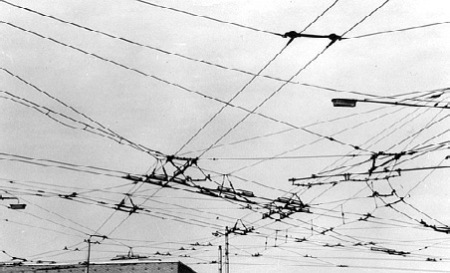
Whether tram/trolleybus wires look unsightly is subjective and not noticeable to those who’ve grown up with them. We learn to take lots of things for granted. I’ve never heard one complaint on the subject where new tram systems have sprouted in the last twenty years. I think it’s worth airing a 1960’s photo I took of the most complicated junction in Portsmouth, Fratton Bridge, where a policeman stood on a box on point duty for many decades, in all weathers, gathering many accolades when he finally retired. The junction was tricky, with traffic congestion and a climb to the bridge. It meant slick work, momentarily accelerating, then coasting across a frog, to go the right way. Rarely did the trolleybus drivers get it wrong.
Chris Hebbron
28/06/12 – 07:29
Thanks Alan and Chris…I was beginning to wonder if I was alone in my love of trolleybus overhead. There was a similar pattern of overhead at Four Lane Ends, in Bradford, with an acute right turn for the 31 Allerton route, which this photo puts me in mind of!
As you say, Chris, how drivers managed the "off" insulated sections at such complicated junctions amazes me…it is a lost skill, and the "roof drum" on the top deck was music to my ears!
Bradford also had the advantage, until about 1962, of a batch of trolleys which made "tram like" sounds, and were unique as such, being regenerative AEC 661Ts with EEC equipment, and double reduction rear axles.
Being a passenger on the top deck, as a "Regen" eased its way across Four Lane Ends, was like being in the orchestra stalls! Lovely sounds…..What a shame we cannot capture it for the sound section of this wonderful site!
John Whitaker
28/06/12 – 07:30
I always thought trolleybus overhead quite attractive but I must admit Chris, your picture of Fratton Bridge is a bit "over the top", or should that be "over the head"?
Eric Bawden
28/06/12 – 07:31
Now that, to me, is beautiful in its own way, Chris, but, as you say, it all depends on what you’re used to I suppose and it’s important to draw attention to the skill required by trolleybus drivers; although the streets were generally quieter than city streets today it was, as you’ve pointed out, no mean feat to get a trolley smoothly from A to B, remembering where to apply power and where to coast and which frogs were automatic and which were manual. Let us also not forget the poor conductor/tress who (depending on the system) may have had to break off from collecting fares to pull a frog, then chase after the bus and jump onto the platform as it started to accelerate away. There’s a perfect example of this on the ‘Online’ video/dvd of South Shields Trolleybuses filmed at the Marsden Inn where the conductor has to chase after his bus as it circumnavigates the roundabout and heads for Horsley Hill Road. The roundabout is still there today but anybody attempting to run round it now would be promptly flattened!
Alan Hall
28/06/12 – 07:32
Now I’ve upset the trolley-lobbey! It was not intentional. I know they had "the power station behind them when going up Church Bank" but was only trying to say that without hindsight, it probably seemed (& perhaps was) the right thing at the time… the infrastructure was often worn out & needed redesigning (in Bradford to put up proper street lights, if I recall, and not brackets on trolley poles) and the buses aged. There was probably no generally available power back up (hybrid etc), which would make such a difference, although I don’t go all the way with with the redevelopment argument- same goes for all services. The same argument applied to London Underground until recently- worn out, but then the money had to be found. This could however (Leeds) be the age of the "new" Trolley!
Poking around, I found a lovely Bradford scene on Youtube: a dewiring (frog broken?). Up comes the little Austin (?) tower wagon, man climbs straight on roof of bus & fiddles: eventually bus sets off, man then grabs trolley booms & holds them off the wires across the faulty frogs. Would they have survived that guardian of us all, Elfansafety?
Joe
28/06/12 – 07:33
You could probably shelter from the rain under that lot!
Stephen Ford
28/06/12 – 10:19
No Joe, you are quite right about the "Elfansafety" aspect!
It would be impossible to turn back the clock, even were we to acquire such power, as the dreaded E and S would prohibit every human activity which then existed!
I can wax very lyrical about all aspects of transport, especially trams and trolleys, but also old motorbuses in general, and Tilling/Bristol flavour in particular, and, to me, that is the beauty of this site….it is a "broad church" of genuine enthusiasm!
John Whitaker
28/06/12 – 10:20
It was impressive, likeable or not! The bridge crossed the main train lines into Pompey. Good job they worked on the tidy third-rail system. Imagine all that catenary below and trolley overhead above!
One other minus point about London trams/trolleybuses, at least, and that was the fact that London Transport had to pay an annual wayleave for its poles to the various local councils, which must have cost a pretty penny!
Chris Hebbron
29/06/12 – 07:47
As is well known Leeds was a pioneer of trolleys along with Bradford but found the tram a better option. Some of the trolleys run by Leeds were truly bizarre including some awesome looking deckers. The new trollies if and when they appear will be efficient but will undoubtedly lack the charisma of the originals.
Chris Hough
30/06/12 – 17:56
If anyone owns a copy of the 1963 J. Joyce book "Trolleybus Trails" they will see another "attractive" shot of overhead wiring on p. 74, taken at the TRTB garage at Cargo Fleet!
Dave Towers
02/07/12 – 07:15
As a youngster, growing up in Bingley on the edge of Bradford CT territory, I too had a fascination for trolleybus overhead wiring. The turning circle at Bingley parish church was the terminus of the Bingley route (26), while trolleys bound for Crossflatts (24) continued straight on. I can vividly recall the ’26’ trolleybuses stopping short of the turning circle, and the conductor/conductress alighting to pull the handle at the side of the traction pole, in order to set the frog (points) for the turn. To a youngster, watching the whole process was simply mesmerising! However, on trips to Bradford, the overhead at Saltaire roundabout could be observed, and this was in a totally different league. Here, trolleybuses terminated from Bradford via Manningham Lane (25) or via Thackley and Shipley (40), negotiating the roundabout from different angles to return to the city. The Bingley and Crossflatts trolleys also navigated the roundabout to continue their journeys on the 24 and 26 routes. Added to that, Saltaire trolleybus depot was adjacent to the roundabout, and had its own wiring ‘roads’ on and off it. An amazing feat of electro-mechanical engineering, and to my eyes, quite beautiful in its own functional, industrial way. (Fred Dibnah would understand!). Just to add even more interest, there was a trolleybus reverser ‘just around the corner’ at the end of Dove Street. Although I never saw this in day to day use, presumably it would have been used by the ’40’ trolleybuses, allowing them to avoid negotiating the roundabout when road traffic was heavy.
Brendan Smith
02/07/12 – 11:18
I’d forgotten ‘reversers’, Brendan, but now recall that Portsmouth had two of them, although one went early on, when the route was closed. Most of the frogs I noted in South-West London, were manually operated by conductors from a traction pole. Just another job for those unsung, hard-working, nimble employees, dealing with 70-seater, not 56-seater, vehicles!
Chris Hebbron
02/07/12 – 18:07
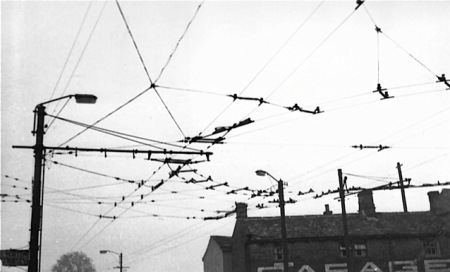
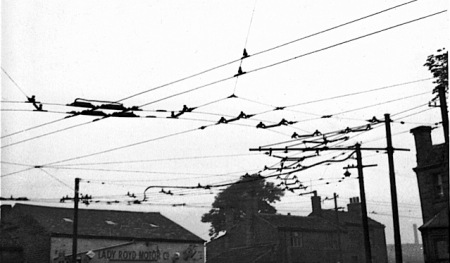
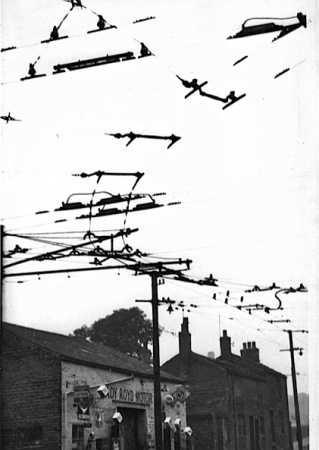
The comments about trolleybus overhead wiring in Bradford made by Brendan about Saltaire and my best friend John W about Four Lane Ends have stimulated my own fascination for complex junctions. I took some photos of Bradford Four Lane Ends wiring in 1958, just before the junction was changed to a "round the block" layout to permit longer trolleybuses to negotiate the sharp right turn for the Allerton 31 route. The Thornton trolleybuses worked the auto point for the straight- on 7 route. I have included one of these photos looking west towards the outward Thornton route where the sharp right turn for Allerton can be seen. The other parts of the wiring include a full circle used for depot access/egress and for short working services from the city as well as for driver training.
Richard Fieldhouse
03/07/12 – 07:14
Brendan, I well remember all these features – particularly the Dove Street reverser used in emergencies. There were other turning circles on the Manningham Lane route – at Lister Park originally a long loop via Oak Lane, St Mary’s Road and North Park Road which was used as a siding for football specials,(later supplemented by the addition of a turning facility at the bottom of Oak Lane), at Ashfield Avenue Frizinghall (27) (a very tight turn), and at Nab Wood on the Shipley/Bingley boundary. There were different styles of overhead in Bingley and interestingly the wiring outside the Bradford City boundary was actually owned by Shipley and Bingley UDC’s and was left in situ for some time after the Bradford wiring had been dismantled, (possibly pending a negotiation of cost of removal versus scrap value !).
Gordon Green
03/07/12 – 07:15
Impressive, Richard. A complete circle would be unusual, I’d venture to suggest.
Chris Hebbron
03/07/12 – 10:55
These pictures of Four Lane Ends really bring the memories flooding back, Richard!
Bradford, as a major player in the trolleybus field, perhaps did not have a junction as complex as Pompey`s Fratton Bridge, but as highlighted by Gordon and Brendan, there were other gems on the system as well as FLE, and I remember the Dove Street/Saltaire layout with great affection. We would often, in the 1950s, take the trolley to Saltaire, where we were always made welcome at the adjacent depot, by our old friend, the depot Superintendant, Mr Harold Brearley, who was himself an enthusiast, and contributed to trolleybus literature in the early days.
There was a section of very modern wiring, by "Ohio Brass", on the Nab Wood-Bingley section too, which deserves mention, but our "home" depot was Duckworth Lane, and Four Lane Ends was in the heart of "Duckworth" territory, and that is where the strength of my memories is based. I can still see a single decker, probably 570 or 571, turning at Four Lane Ends about 1945! It was also, of course, the heart of "Regen" territory, where those extra special trolleybuses, 597-632, groaned about on their everyday business, sporting the wonderful Tattam livery with cream bands, grey roofs, black beading, and yellow lining, and to top it all, our absolute favourite buses of all time, the 9 Brush rebodies of 1944!
I can remember my time at Fairweather Green Infants School, between 1946 and 1950, where playtimes were regularly spent with nose pressed through the railings, to watch the 3 types of "Regen" rebody pulling up at the Mumby Street stop. Every so often, during the same vigils, a cloud of dust would shroud a West Yorkshire Bristol G, as it hurtled past on the Bradford-Denholm-Keighley route! Lets all revel in nostalgia….you can`t beat it!
Moved away from Newcastle a bit though. Sorry about that!
John Whitaker
04/07/12 – 05:04
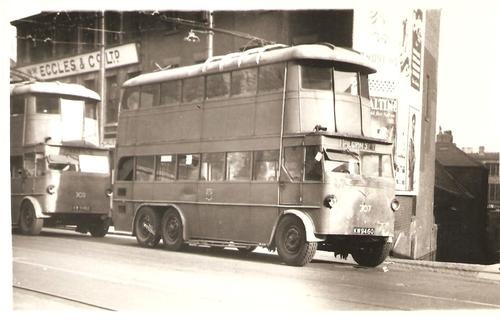
John Whitaker is not as far off the original subject as he seems to think he is, once again the picture is from Newcastle City Libraries, but it’s of two Bradford trolley buses ‘ten in total’ that wandered all the way to Newcastle, I’m not entirely sure of the registrations but I think were KW 5453/62. They were Dick KE/English Electrics’ built for Bradford in 1931, and acquired by Newcastle in 1942 where they became 300/9; I think they must have found their way to Newcastle as part of a wartime redistribution of resources, and I think they remained in service until about the late 40’s
Ronnie Hoye
04/07/12 – 10:43
Well Ronnie, you have made my day! I have never seen a photo of one of the Bradford six wheelers as running in Newcastle, so many thanks.
Bradford received 10 of the Sunbeam MF2 chassis diverted from the Johannesburg order, under a MOWT allocation in 1942. These became BCT 693-702, always referred to as "Joburgs".
The MOWT directed that BCT sell a similar number of older vehicles to Newcastle, with the result that 1929/30 vehicles, 573, 579, 580, and 7 of the 1931 batch, 584, 585, 586, 591, 592, 594, and 595 proceeded north to NCT.
The Bradford batches were 572-583, KW 6062-7, 6654-9, and 584-595, KW9453-64.
My records show the Newcastle numbers as 306, 309, 308, 303, 304, 305, 307, 301, 302, and there is some doubt that the earlier 3 buses ever ran in Newcastle. One of each type, plus the demonstrator, 596, were sold in 1945 to South Shields.
The wheel has turned full circle Ronnie, and thanks again. If you have any further detail concerning the lives of these vehicles with NCT, I would be delighted to hear.
There were only 9 numbered by NCT, as 595 was broken up for spares.
John Whitaker
04/07/12 – 15:41
Re John W’s posting, I was just pondering how they were actually taken up to Newcastle? I assume they must have been towed by a Bradford tow truck which most likely was an even older former bus. Finding any photographs of the journey would be fascinating as it must have been a slow task.
Richard Leaman
04/07/12 – 15:42
What a wonderful surprise to see a photo of two ex Bradford trolleybuses operating in Newcastle. The two shown had contactor control but had a primitive style of master controller that required a third pedal that was tripped after each electric brake application. This trip pedal action reset the contactors again for a power application. The term "trippler" was used for these trolleybuses by the drivers in Bradford where they were based at Bolton depot. We rarely saw one of these "tripplers" at Four Lane Ends but the earlier EEC 3 axle types with direct mechanical cam controllers did appear. These trolleybuses were hard work to drive as the power pedal had to be continually pumped to get the required power and braking. These trolleybuses were known in Bradford by the drivers as "paddlers". It is said the drivers paddled in their sleep.
Richard Fieldhouse
04/07/12 – 16:30
Its a fascinating point, Richard, about how the Bradford "Trippler" trolleys got to Newcastle. I presume they were towed up, but by whom, and how, I have no idea!
There were several instances of wartime trolleybus loans, and, amongst these, some Bournemouth trolleybuses ran in South Shields! It is also interesting to note that also, in 1942, Bradford abandoned its Stanningley tram service, as the track was desperate! The MOWT arranged loan motorbuses, Regents from Leeds, and STs from London, and 10 "Preston" cars of 1919/21 vintage were sold to Sheffield, who also received some Newcastle Hurst Nelson cars. Presumably such movements were by low loader. You never know what might appear on this site….just look at Ronnie`s photo today!
John Whitaker
05/07/12 – 06:54
Thx for this amazing photo, Ronnie. These old warhorses are seriously unattractive and, it would seem, crude, even for their day. the 1931 ‘Diddlers’ were not like this at all. There was some discussion on another posting about trolleybus movements in the war – see this Old Bus Photos link
I would doubt if any such movements were by low-loaders, much more a recent invention, apart from ‘Queen Mary’s’ which move dismantled planes around during/after the war. They would have been towed, as Richard L suggests.
The MofWT must have had some challenges to meet at times, such as the late 1940 Coventry Blitz, which wiped out the city’s tram system permanently! And a similar end came in Bristol, in 1941,when bombs damaged a bridge carrying the tramway power supply. How they kept public transport going, with minimal interruption, in such conditions, was amazing.
Chris Hebbron
05/07/12 – 06:55
Bradford’s Stanningly tram service was originally a through joint route between Leeds and Bradford. The two systems had different gauges and the trams where fitted with wheels that could be move on the axle with the tram wheel base widening to standard gauge in Leeds and narrowing to 4ft in Bradford. Sadly through running was abandoned during the first world war Leeds trams turned right to go to Pudsey just before the Bradford Stanningly terminus but this line was cut back in 1939 to Stanningly town street and was totally abandoned for buses in the early fifties. The replacing Bradford bus route was the number 9 and was home to Weymann and East Lancs bodied Regents for many years after the war.
Chris Hough
05/07/12 – 06:57
There’s a picture on p146 of "Blue Triangle" by Alan Townsin of an AEC Mammoth Major 8 wheeler loaded with engines leaving the AEC works in 1941/2 and towing a new AEC 661T trolleybus for Notts. & Derby Traction Co. I suppose therefore that trolleybuses would be towed up and down the country by whatever means was available at the time. I wonder if any were towed by steam waggon to save on fuel oil?
Eric Bawden
05/07/12 – 06:58
The same photograph of no. 1 (formerly Bradford 592) and taken in Byker depot appears in both ‘The Trolleybuses of Newcastle-upon-Tyne’ by T P Canneaux & N H Hanson and ‘Newcastle Trolleybuses’ by Stephen Lockwood. According to the Canneaux & Hanson book they were originally numbered 1-9 and 0 by Newcastle, 0 being Bradford 595 which was purchased for spares only but allocated a number all the same! The remainder were prepared for, and available for, service but nos. 6, 8 & 9 (Bradford 573, 580 and 579) remained unused. Nos. 1-5 and 7 (Bradford 592, 594, 584, 585, 586 and 591) were still in service at the time of the 1946 renumbering exercise and received the numbers 301-305 and 307. The book records the withdrawal date of all but 304 as 31 December 1948; no withdrawal date is given for 304.
They never received Newcastle livery and operated in Bradford Blue or wartime grey mainly on Pilgrim Street to Walker rush-hour extras.
Alan Hall
05/07/12 – 11:18
You’re right, Chris, they are a bit of an ugly duckling. When compared to the size of the rest of the windows the windscreens look like an afterthought. If Alan H is correct and these buses were finally withdrawn in 1948, then they would have been replaced by the BUT’s that started this discussion, and I think most of us would agree that they were an extremely handsome vehicle.
Ronnie Hoye
05/07/12 – 11:20
I agree that trolleybuses must have been towed. I mentioned low loaders in connection with the wartime movement of tramcars, but perhaps they were moved by railway.
The 1929 "Paddlers" are reported as not running for NCT, confirming my records. This was because of their older control system, detailed by Richard. One of these trolleys went to South Shields in 1945, but it was one which had the "Trippler" control system fitted to it in 1934, after 588 suffered a career ending accident.
The Bournemouth trolleys I mentioned as running in South Shields had also previously run in Newcastle.
John Whitaker
05/07/12 – 11:21
Interesting point, Chris Hough, about the adjustable axles to adapt the trams to the two different gauges. There’s nothing new under the sun as they say. Spanish trains have a wider track gauge than the standard one and post-war, their international trains had similar axles. Now, their new HST/TGV lines have been built to standard gauge.
The Mammoth Major photo sounds, Eric and the thought of using a steam waggon is a possibility. It’s worth recalling that in that period, any lorries much over 3-tonners were restricted to 20mph as well, making the journeys even more tedious! I remember the little 20 (oval?) plates on the back.
Chris Hebbron
05/07/12 – 15:59
Just to clarify my earlier post timed at 06:58 I mean that the same photo appears in both books but it’s not the same photo as Ronnie has posted here. I hope that makes sense now!
Alan Hall
05/07/12 – 16:01
My, how we move about! I don’t mind though…perhaps we should have a free discussion section. Bradford and Leeds dual gauge tram route is well documented in tramway literature, so I won’t mention it here, but coming back to the Bradford "Tripplers", I would suggest that beauty is in the eyes of the beholder! The LUT "Diddlers" were a year newer, and were AECs anyway, and, in my mind, hardly attractive, with their half cab/bonnet layout.
These were the times of rapid design, and the "art deco" movement. EEC were trying to establish a fashionable shape, and similar bodies were supplied to Nottingham, on EEC 6 wheeler trolleybuses, and 1929 AEC Regents, some of the latter having centre entrances. See David Beilby`s wonderful gallery.
It was not until late 1931 that the popular "standard" 6 bay EEC body appeared.
The Nottingham C/E Regents were an attempt to establish a new norm for entrance position too, and must have been quite revolutionary for their time, and they were a year before the Roe/Grimsby experimental bus which set a later trend, albeit single staircase.
There, I’ve set us off in a new direction! My mind leaps all over the place!
John Whitaker
05/07/12 – 16:01
Thinking just a bit more about moving these vehicles about, just imagine the journey being towed along at no more than 20 mph and then what route would they take because at that time virtually every main road would have been crossed by low bridges, most of which have since been demolished. It must have taken days to get there and a lot of planning.
Richard Leaman
05/07/12 – 17:01
I should’ve made it clearer, John W, that my thoughts were more concerned with the technical side of things than body aesthetics. Dick, Kerr were very much a tram builder and I suppose that their thoughts still leaned in that direction when building trolleybuses. In fact, I didn’t realise that they’d built any. I would not say the the ‘Diddlers’ were the best-looking bodies, but they did give more than a nod to art-deco, whereas the ‘Tripplers’ seemed to have been designed by two people, one putting a stylish (of a sort)upper deck front on it and the other putting a box on the bottom half, with more than a nod at art-garden shed. See?! Speaking one’s mind is not only the prerogative of Northerners! So, as they trendily say, live with it!!
Chris Hebbron
06/07/12 – 07:09
Well Chris, nowt to get excited about! EEC had built trolleybus bodies since 1926, and possibly earlier under the UEC name on the initial Tees Side fleet, and they had of course, been building bus bodies for some time before that. The first trolleybus body was on modified Leyland PLSC1 chassis in 1927, as a demonstrator, finishing up as Bradford 560. Then, in 1931, they signed the agreement with AEC to build trolleybuses as a joint venture, and this is the time when they were seriously experimenting with shape and design. Bradford 584-595 were the last of the EEC chassis produced, but I believe the last of all were the initial Notts and Derby fleet of single deckers.
It was some time before the acceptable shape of a trolleybus front end was established. Experiments continued to about 1935, with half cabs, dummy radiators, ridged windscreens etc, before the flush front became very much the norm.
John Whitaker
06/07/12 – 14:21
I think you’re right, John, about trolleybus design, which seemed to go through a more extreme fluctuation of style than motor buses, before settling down. Maybe it was the full-fronted aspect which caused it. Many early bodies were made to look just like motor buses – half cab with radiators! I always thought that after LUT’s ‘Diddlers’, their next offering, the essentially 1931 AEC/LGOC X1, set the future style for trolleybuses, and, as it happens for the double-deck AEC Q motor bus. See this link.
And with LUT’s X1, we can basically come the full circle to the the Newcastle trolleybuses above!
Chris Hebbron
07/07/12 – 06:54
I agree about LT X1 Chris, and recommend the Capital London trolleybus book to you…see the LB post, where LB5s were converted to tower wagons amongst others.
My final note on Tripplers….It matters not what aesthetic responses they now draw. It was an explosion of fashion "pushing" at the time, in 1931.
Living in the South and Midlands myself, for most of my life, may I trendily say "Move on"!!
John Whitaker
07/07/12 – 12:13
Will look out for the book you mention. I confess, that despite growing up in ‘Diddlerland’, the only LT trolleybus service vehicles I ever saw were AEC Mercuries. Being bought new, they may well have lasted longer than the LB5’s, or not been assigned to Fulwell Depot.
Chris Hebbron
09/07/12 – 07:34
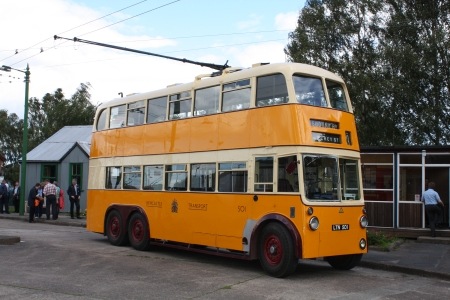
Apologies for it being a member of the batch following those being discussed but I thought you might appreciate a colour photo of a Newcastle Trolley rather than the black and white images featured so far.
Andrew Charles
09/07/12 – 15:55
I believe these were Sunbeams, and they came between the two batches of BUT’s. I know the bodies were built in Newcastle by Northern Coachbuilders and being a local lad I should prefer them, but to me the MCCW bodies ‘especially the LT ‘Q’ style just look so much better, but to be fair, these lasted well and gave good service, and as has been said before on this subject, beauty is in the eye of the beholder.
Ronnie Hoye
24/12/13 – 06:51
On the subject of trolleybuses and town centre re-development, I have read that a one way system in Reading town centre overlapped by a year or so the end of the trolleybus system there, and, as the expense of rewiring to suit the new road layout was not justified, the UK’s first contra-flow bus lane was the result.
Geoff Kerr
24/12/13 – 08:28
Don’t know about that, Geoff, but Reading Council were serial tinkerers. On occasional Saturdays and during school holidays I would venture to Reading from my High Wycombe home to drive for Reading Mainline. My first question was always "Where am I going?", the reply "Well you know the route." It seemed for a time, though, that the road layout changed every time I went up to Reading. Kings Road changed from Bus Contraflow to standard and back a number of times, as did the Butts, and this was just in the period 1996 – 2001.
David Oldfield
31/03/14 – 17:52
Further to the query regarding the withdrawal of 304. (5/7/12 – 06:58) PSV Circle fleet history PA16 shows that it was withdrawn in 1948 and it’s disposal as:- Hope (Dealer), Hexham, 1949, for scrap.
Ian Hignett
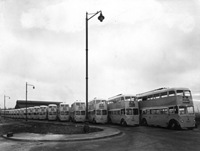 Vehicle reminder shot for this posting
Vehicle reminder shot for this posting
04/06/20 – 07:14
With reference to Ronnie Hoye‘s rare photo of Bradford trolleybuses in Newcastle upon Tyne, I was not old enough to remember them in service. However, not all of these were scrapped after being withdrawn, One found its way further north up the Northumberland coast and was used as a holiday cottage between the villages of Low Hauxley and Amble, surviving well into the mid 60s. I don’t have a photograph of this but remember seeing one in Ian Allan’s publication, Buses Illustrated around 1963.
Ray Jackson
06/06/20 – 06:45
Ray, there is an article (‘Silent Transport – Newcastle trolleybuses over 30 years’) in the November 1965 issue of Buses Illustrated, including a three-quarter offside view of the ‘holiday cottage’ trolleybus you mention. Outwardly the paintwork looks quite tidy, but the lower deck is showing serious signs of bulging in the first four bays. The caption reads "One of ten English Electric six-wheeled trolleybuses bought from Bradford in 1942 survives as a caravan at Low Hauxley on the Northumberland coast", so you are spot-on with your recollections. Sadly there are no clues as to it’s identity, although it probably wasn’t KW 9464 (ex-Bradford 595), as according to the NCT trolleybus fleet list shown in Part 2 of the article in BI January 1966, this was acquired for spares only.
As Ronnie comments on 4/7/12, the ten trolleys acquired were built in 1931 and the operational ones were numbered 1-9 (KW 9461/63/53/54/55/63/
60/56/55) by NCT. In the NCT registration number order shown, they would have been Bradford 592/594/584/585/586/594/591/587/586.
Brendan Smith
07/06/20 – 09:32
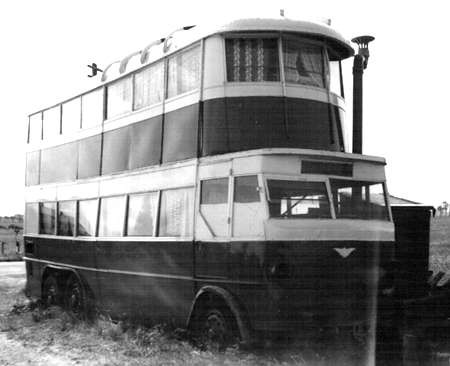
Ray, that pic appeared in part 1 of Noel Hanson’s Buses Illustrated article about Newcastle trolleys in Nov 1965. It’s one of Bob Davis’s.
Here’s a scan of the print. Can’t find a record of its number.
Tony Fox
08/06/20 – 07:28
Thank you to Brendan and Tony for posting the information regarding the Bradford trolleys. After scouring my old collection of Buses Illustrated I realised that my original recollection of the article by Noel Hanson was two years out. The EEC body pictured, was looking in a bad way probably because of being exposed to the damp sea air for a many years. I remember its colour scheme being a dark green and cream when I last saw it but it still looked quite smart overall.
Ray Jackson
